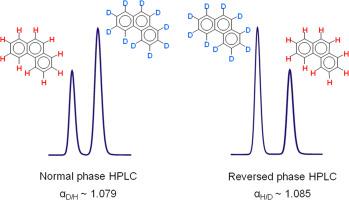有机化合物中同位素物的高效液相色谱分析教程
IF 3.2
引用次数: 0
摘要
在特定化合物的一个或多个原子中分离具有不同中子数的同位素或化学物质是一项重要但困难的任务。高效液相色谱(HPLC)的应用,通过不同的同位素效应,为同位素物的各种分离方式提供了一定的灵活性。本教程描述了基本的同位素效应(疏水性、极化性、酸碱性质、大小差异等),这些效应会影响HPLC分离同位素物的性能。本文主要研究了氘化有机化合物的分离选择性,考虑了不同的性质。讨论了先进吸附材料和技术的应用。本文章由计算机程序翻译,如有差异,请以英文原文为准。

Tutorial on high-performance liquid chromatography of isotopologues of organic compounds
Separation of isotopologues or chemical species having different number of neutrons in one or more atoms of specific compound represents an important but difficult task. Application of high-performance liquid chromatography (HPLC) provides some flexibility in various separation modes of isotopologues via different isotopic effects. This tutorial describes basic isotopic effects (hydrophobicity, polarizability, acid-base properties, size difference, etc.), which can influence HPLC performance in the separation of isotopologues. The article is focused on separation selectivity of deuterated organic compounds, for which different properties are considered. The use of advanced adsorption materials and techniques is discussed.
求助全文
通过发布文献求助,成功后即可免费获取论文全文。
去求助
来源期刊

Journal of chromatography open
Analytical Chemistry
CiteScore
2.50
自引率
0.00%
发文量
0
审稿时长
50 days
 求助内容:
求助内容: 应助结果提醒方式:
应助结果提醒方式:


